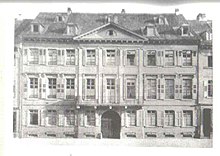Kraichgauer noble women's monastery
The Kayserliche Reichsfreye Adeliche Creichgauerischen Fräulein-Stifft , later renamed the Kraichgauer Adeliges Damenstift , was founded in 1718 by Amalia Elisabeth von Mentzingen, née. von Bettendorff , founded. In her will, she decreed that with her parental inheritance, aristocratic evangelical women from the knightly canton of Kraichgau should be able to live a withdrawn but befitting life if this could not be guaranteed by their families.
history
Amalia Elizabeth of Mentzingen the establishment decreed on August 12, 1718 last will and testament of a secular pin for needy Protestant lady from families of Kraichgauer Ritter Canton. The knightly canton of Kraichgau (original considerations also included the knightly canton of Odenwald) was appointed as executor of the will, so that the foundation was in fact subordinate to the imperial knighthood. The estate in Bockschaft, acquired by the von Mentzingen family from the von Helmstatt family in 1715, was transferred to the foundation from the Mentzingen will, and the Gröbernhof in Harmersbachtal followed later. Endowments from the von Venningen and von Bettendorf families significantly increased the foundation's capital base. Together with her husband, the donor bought a villa from Colonel Sergeant Peter de la Reintrie in 1720 at Schlossberg 11 in Pforzheim, then Baden . In this house the convent, the abbess and six canonesses took their seat.
The decision to relocate the monastery in Pforzheim in Baden brought plenty of margravial privileges (customs privileges, tax exemptions, etc.) for the monastery. However, this resulted in repeated conflicts between the imperial knighthood on the one hand, who saw the monastery at the mercy of a sovereign, and the Baden margraves, on the other hand, who claimed legal sovereignty in their area, in particular the jurisdiction of the Baden court for the monastery.
On November 7, 1721, the first abbess, Rosina Susanna Catharina Philippina von Venningen, solemnly took over her office. In 1722 the neighboring building Schlossberg 9 was acquired. Farm buildings later added to the ensemble. On January 29, 1725, the monastery received the imperial confirmation as an imperial directors, incorporated into the knightly canton Kraichgau, and thus had the rank of imperial baron .
With the dissolution of the knightly canton Kraichgau in 1806, a family council was entrusted with the administration of the monastery, consisting of members of the families of the former knightly canton Kraichgau. This structure still exists today.
After an advantageous exchange of land in Pforzheim in 1835, the convent moved into a stately palace in Langen Strasse in Karlsruhe (today Kaiserstrasse 241, but the building was demolished in 1917). In 1871 the common household of the canons was given up, but the legal form as a convent and foundation under public law was largely retained. From 1919, parts of the monastery archive were moved to the General State Archive in Karlsruhe .
The women's pen today
The pen still exists today. The purpose of the foundation is still to support needy Protestant women, especially single or widowed members of aristocratic Protestant families in the former knightly canton of Kraichgau. Donations can also be made to charitable organizations for youth and elderly care, welfare and local history. In 1999 the foundation's assets included a. 257 hectares of arable land and 18 hectares of forest. Once a year, usually around August 12th (testament date), the monastery invites its members to a meeting to present the annual report with food and visits. Former sites of the Kraichgau Imperial Knights are preferred. The Kraichgauer Adelige Damenstift is the last remaining institution of the former Kraichgauer Imperial Knights.
List of Abbesses
- 1721–1738 Rosina Susanna Freiin von Venningen (since it was founded in 1718, but solemnly appointed on November 7, 1721)
- 1733–1770 Dorothea Sybilla Freiin von Mentzingen
- 1770–1775 unoccupied
- 1775–1802 Sophie Friederike Freiin von Holle
- 1802–1816 Auguste Elisabeth Freiin von Seckendorff
- 1816–1823 Christine Juliana Freiin von Gemmingen
- 1823–1844 Klara Henriette Freiin von Seckendorff
- 1844–1856 Karoline Freiin von Degenfeld
- 1856–1859 Jeanette Freiin von Neubronn
- 1859–1891 Marie Freiin von Mentzingen , † 1901
- 1901–1913 Oktavia von Stein-Nordheim
- 1913–1947 Johanna Karolina Augusta Freiin Wolfskeel von Reichenberg
- 1948–1951 Emma Freiin von Racknitz
- 1951–1981 Elfriede Freiin von Hügel
- 1981–1994 Marianne Countess Zedtwitz
- since 1994 Gabriele Freifrau von Gemmingen-Guttenberg
literature
- Bened. Black: History of the evangelical secular Kraichgau aristocratic women's monastery . Karlsruhe 1918.
- Hans Georg Zier: History of the City of Pforzheim , Stuttgart 1982, pp. 132-134.
- Konrad Krimm and Heinz Maag: eagle and crown of thorns, 275 years of the Kraichgau noble women's foundation. Self-published by the Kraichgauer Adeligen Damenstift, Karlsruhe 1993
- Kurt Andermann: “To the glory of Almighty God and the service of one's neighbor”. The Kraichgau noble women's monastery . In the S. (Ed.): Spiritual life and living according to class. Noble ladies' pencils in the past and present (= Kraichtaler Colloquia . Volume 1). Tübingen 1998, pp. 91-106.



